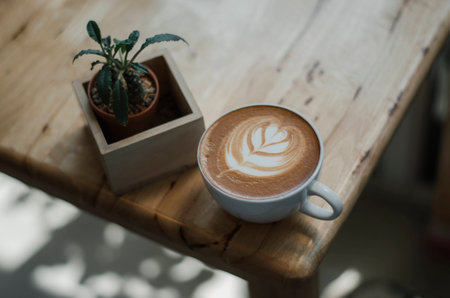1. Introduction: Britains Evolving Coffee Palate
Over recent years, Britain’s coffee culture has undergone a remarkable transformation. Once synonymous with traditional tea drinking, the British public is now developing a sophisticated appreciation for speciality coffees—particularly single-origin beans that highlight the unique flavours of their growing regions. Among these, coffees sourced from Asia and the Pacific are capturing the attention of discerning British consumers and baristas alike. As tastes evolve beyond ubiquitous blends, there is an increasing curiosity about the stories, terroirs, and nuanced profiles offered by single-origin coffees from countries such as Indonesia, Vietnam, Papua New Guinea, and India. This shift reflects not only a desire for quality but also a willingness to explore diverse coffee experiences that align with Britain’s multicultural identity and penchant for culinary discovery.
2. A Region Rich in Terroir: Flavour Profiles of Asia-Pacific Coffees
When examining single-origin coffees from Asia and the Pacific, one is immediately struck by the depth and diversity of terroir-driven flavour profiles. For British coffee enthusiasts accustomed to the bright acidity of Kenyan beans or the fruity clarity of Colombian varieties, coffees from Indonesia, Vietnam, India, and Papua New Guinea introduce a distinctive spectrum of tasting notes. These origins reflect unique agricultural practices, microclimates, and post-harvest processing methods that set them apart from their African and Latin American counterparts.
Distinctive Tasting Notes from Leading Asian Origins
| Country | Signature Flavour Notes | Processing Methods | How It Differs from African/Latin American Origins |
|---|---|---|---|
| Indonesia (Sumatra) | Earthy, spicy, herbal, full-bodied with low acidity; often hints of tobacco and dark chocolate | Wet-hulled (Giling Basah), natural | Lacks the high acidity and citrusy brightness typical of East African coffees; more rustic and syrupy mouthfeel compared to washed Latin American beans |
| Vietnam | Nutty, chocolatey, sometimes smoky or peppery; predominantly robusta, with emerging arabica profiles offering subtle fruitiness | Natural, honey, washed (in select regions) | Robusta’s boldness contrasts with the floral lightness of Ethiopian or the caramel sweetness of Central American beans; Vietnamese arabica is smoother but less acidic than most African origins |
| India (Monsooned Malabar) | Mellow, musty, woody, slightly spicy; very low acidity with a smooth finish | Monsooning (exposed to monsoon winds), natural, washed | The monsooning process imparts a unique aged character absent in both African and Latin American coffees; softer palate and heavier body than classic washed origins |
| Papua New Guinea (PNG) | Citrus zest, tropical fruit, sweet herbs, delicate florals; lively acidity balanced by silky body | Washed, natural | Shares some attributes with East African coffees but generally softer and more approachable; less intense berry notes than Kenya or Ethiopia but brighter than most Indonesian lots |
The Influence of Terroir on Cup Profile
The geography and climate of Asia-Pacific regions—ranging from Indonesia’s volcanic soils to the misty highlands of Papua New Guinea—create coffees that are notably different in cup character. British palates might find Indonesian Sumatran beans ideal for espresso blends due to their earthy intensity, while PNG’s nuanced flavours can shine in filter brews. Indian Monsooned Malabar offers an unparalleled smoothness that pairs beautifully with milk—a key consideration given Britain’s fondness for milky coffee drinks.
Brew Recommendations for British Coffee Lovers
- Savour Indonesia: Try as a single-origin espresso or in a cafetière for a rich morning cup.
- Vietnamese Robusta: Excellent in traditional phin filters or as a base for iced coffee—perfect for experimenting beyond the usual flat white.
- Indian Monsooned Malabar: Ideal for those who prefer gentle bitterness without sharp acidity; works well in moka pots.
- Papua New Guinea: Highlight its delicacy using a pour-over method to capture floral top notes.
A Distinctive Addition to British Coffee Culture
In sum, exploring Asian single-origin coffees is not merely about discovering new flavours—it’s about expanding our sensory vocabulary and appreciating how terroir can redefine our understanding of what makes a memorable brew. With so much variety at hand, these origins offer British drinkers a compelling alternative to familiar African and Latin American favourites.

3. Roasting Approaches: Highlighting Unique Characteristics
When it comes to roasting single-origin coffees from Asia and the Pacific, a nuanced approach is paramount to truly bring out their distinctive qualities. British roasters, with a legacy rooted in both tradition and innovation, are particularly adept at navigating these complexities. The beans from this region—ranging from Indonesian Sumatran to Vietnamese Arabica and Papua New Guinean Typica—often present unique challenges and opportunities in the roastery.
Understanding the Regional Profiles
Coffees from Asia and the Pacific typically showcase earthy, spicy, and sometimes herbal notes, alongside a syrupy body and low to moderate acidity. These attributes require careful management during roasting to avoid muting subtle flavours or overemphasising rustic qualities. Unlike Central or South American coffees, which often benefit from lighter roast profiles to accentuate acidity and fruitiness, these origins can thrive under slightly deeper development without sacrificing complexity.
Tailoring Roast Curves for Complexity
To unlock the full potential of these beans, British roasters often employ bespoke roast curves. A controlled yet assertive Maillard phase helps enhance sweetness and body, while a restrained first crack ensures that volatile aromatic compounds are preserved. For example, Indonesian coffees may be roasted to a medium level to highlight their chocolatey undertones and maintain clarity, whereas a Papua New Guinea might respond well to a lighter profile that teases out floral nuances while retaining balance.
British Roasting Traditions: Marrying Heritage with Innovation
The British coffee scene has historically leaned towards darker roasts—think classic Italian-inspired espresso blends popularised by high street cafés. However, the contemporary wave of specialty roasting has ushered in a preference for precision and transparency. Today’s British roasters strike a balance between heritage and modernity by adapting traditional slow-roast methods for today’s lighter styles. This approach allows Asian and Pacific single-origins to shine on their own merit, whether brewed as an espresso or filter coffee.
Ultimately, crafting the ideal roast profile for these unique beans demands both technical expertise and an appreciation for their provenance—a hallmark of British roasting culture that champions diversity in flavour while honouring the traditions that have shaped our national coffee palate.
4. Brewing Methods and British Preferences
In the UK, coffee culture has evolved considerably over the past decade, with a marked shift towards specialty coffees and single-origin selections from regions such as Asia and the Pacific. Understanding how popular British brewing methods interact with these distinct origins is essential for both home enthusiasts and professional baristas aiming to unlock the unique profiles of Asian and Pacific coffees.
Cafetière (French Press): A Classic British Choice
The cafetière remains a household staple in Britain due to its simplicity and ability to extract full-bodied flavours. When paired with single-origins from Indonesia or Vietnam, the immersion brewing process emphasises deep earthy notes, syrupy mouthfeel, and subtle spice, making it ideal for coffees with low acidity and bold body. However, delicate floral or citrus notes from lighter-roasted Asian beans may be somewhat subdued compared to more nuanced filter methods.
Filter Coffee: Highlighting Clarity and Nuance
Filter brewing, through methods like the V60 or Chemex, has become increasingly popular in British specialty cafés. This approach accentuates the clarity and complexity of single-origin beans from regions like Papua New Guinea or Thailand. The gentle extraction highlights vibrant acidity, floral aromatics, and intricate flavour layers—qualities highly prized by discerning British palates seeking a refined cup experience.
Espresso: Intensity Meets Exotic Origins
Espresso-based drinks are ubiquitous in UK coffee shops. While traditional espresso blends favour Latin American or African components, adventurous roasters are now incorporating Asian and Pacific single-origins into their espresso menus. Beans from Sumatra or India’s Monsooned Malabar provide robust crema, spicy undertones, and a lingering finish—characteristics that withstand milk-based drinks popular among British consumers.
Comparison Table: Brewing Methods vs. Flavour Outcomes
| Brewing Method | Best Suited Asian/Pacific Origins | Highlighted Flavour Attributes | Potential Drawbacks |
|---|---|---|---|
| Cafetière (French Press) | Indonesia (Sumatra), Vietnam | Earthy, bold body, chocolatey, spicy | Mutes delicate acidity or florals |
| Filter (V60/Chemex) | Papua New Guinea, Thailand | Citrus, florals, clarity, light body | Softer mouthfeel; less suited for heavy-bodied origins |
| Espresso | India (Monsooned Malabar), Sumatra | Spice, crema, intensity; holds up in milk drinks | Loses subtlety; can accentuate bitterness if not dialled in precisely |
Cultural Considerations: The British Approach to Coffee Rituals
The British appreciation for both tradition and innovation is reflected in their embrace of multiple brewing styles. Whether preparing a leisurely French press at home or savouring a meticulously brewed filter coffee in an independent café, there is a growing curiosity about how regional origins from Asia and the Pacific can be showcased through different methods. Ultimately, selecting the right brew method becomes a matter of aligning personal taste preferences with the inherent qualities of each single-origin—an approach that resonates with Britain’s ongoing journey towards greater coffee connoisseurship.
5. Sourcing Sustainably: Ethical Considerations for UK Consumers
As the British coffee scene evolves, there is a growing emphasis on sourcing single-origin coffees from Asia and the Pacific with integrity and transparency. For discerning UK consumers, ethical procurement extends beyond flavour profiles to encompass traceability, direct trade practices, and environmental stewardship.
Understanding Traceability
Traceability has become a cornerstone of ethical coffee sourcing in Britain. UK roasters and consumers increasingly demand clarity regarding the origin of their beans, seeking information about specific farms, processing stations, or even individual farmers across Indonesia, Vietnam, Papua New Guinea, and India. This transparency not only fosters trust but also enables drinkers to appreciate the unique terroirs and cultural narratives behind each cup.
The Merits of Direct Trade
Direct trade initiatives are gaining traction within the British specialty coffee sector. By establishing direct relationships with producers in Asia and the Pacific, UK importers can ensure fair pricing and improved working conditions at source. This approach reduces intermediaries, allowing growers to retain a greater share of profits while guaranteeing consistent quality for the British market. Consumers benefit from knowing their purchases support ethical livelihoods and sustainable development in producing regions.
Environmental Impact and Sustainability
The environmental footprint of coffee production is another critical consideration for conscientious British buyers. Sustainable farming methods—such as shade-grown cultivation, organic inputs, and water-efficient processing—are increasingly valued when selecting single-origin Asian and Pacific coffees. Certifications like Rainforest Alliance or Organic offer some reassurance; however, many UK roasters go further by fostering partnerships with producers who prioritise reforestation, biodiversity conservation, and responsible land management.
Ultimately, embracing traceability, supporting direct trade, and evaluating environmental impact empowers UK consumers to make informed choices that align with their values. In doing so, they contribute to a more equitable and sustainable global coffee industry—while enjoying exceptional single-origin coffees from one of the world’s most diverse regions.
6. Pairing and Serving: A British Cultural Twist
When introducing single-origin coffees from Asia and the Pacific into the British context, there is an exciting opportunity to blend traditional British fare with the distinctive profiles of these unique beans. The nuanced flavours found in coffees from Sumatra, Papua New Guinea, or Vietnam—ranging from earthy and spicy to fruity and floral—can complement and even elevate classic British treats. For instance, the deep, syrupy body of a Sumatran coffee pairs superbly with a buttery slice of Victoria sponge cake, while the bright acidity and tropical notes of a Papua New Guinean brew work wonderfully alongside a zesty lemon drizzle loaf. Even the robust intensity of Vietnamese robusta can find harmony with a hearty full English breakfast, cutting through the richness and providing a bold counterpoint.
Reimagining Coffee Rituals
While tea remains an indelible part of British culture, there is growing appreciation for specialty coffee rituals that draw upon Asian-Pacific traditions. For example, experimenting with Vietnamese-style iced coffee using locally roasted beans introduces a refreshing twist to summer afternoons. Alternatively, incorporating cardamom or ginger—a nod to Indian and Indonesian influences—into home-brewed filter coffee can offer aromatic complexity that feels both exotic and familiar.
Pairing Suggestions for Afternoon Tea
For those seeking to modernise their afternoon tea experience, try serving a flight of Asian-Pacific single-origin coffees alongside finger sandwiches and scones. The floral undertones of a Yunnan coffee can beautifully enhance cucumber sandwiches, while an Indonesian Mandheling’s chocolatey depth brings out the richness in clotted cream and strawberry jam.
Celebrating Diversity in Every Cup
Ultimately, embracing single-origin coffees from Asia and the Pacific within British culture means more than simply swapping tea for coffee; it invites us to broaden our palates and celebrate diversity at the table. By thoughtfully pairing these coffees with beloved British dishes and integrating new brewing methods, we create memorable experiences that honour both tradition and innovation.
7. Conclusion: The Future of Asian-Pacific Single-Origin Coffees in the UK
As the British specialty coffee scene continues its dynamic evolution, single-origin coffees from Asia and the Pacific are poised to play an increasingly influential role. Over recent years, there has been a marked shift in consumer preferences, with discerning drinkers seeking out traceability, unique flavour profiles, and ethical sourcing. This trend has positioned Asian-Pacific origins—from Sumatra’s syrupy body to Papua New Guinea’s bright acidity—as sought-after choices for both cafes and home brewers across the UK.
The rise of third-wave coffee culture has not only broadened palates but also fostered an environment where transparency and provenance are highly valued. British roasters and importers have responded by forging direct relationships with growers in regions such as Myanmar, Vietnam, and Thailand, ensuring quality control while supporting sustainable practices. This collaborative approach resonates strongly with eco-conscious British consumers who value both cup character and positive social impact.
Looking forward, the future appears robust for Asian-Pacific coffees within the UK’s vibrant market. Roasters are experimenting with innovative processing methods—such as honey and anaerobic fermentation—to highlight origin-specific nuances, while baristas embrace these coffees in competitions and seasonal menus. As more British coffee drinkers become attuned to the complexities of terroir-driven flavours—ranging from the spice-laden notes of Indian Monsooned Malabar to the delicate florals of Yunnan—the demand for distinct Asian-Pacific profiles is set to grow further.
In summary, single-origin coffees from Asia and the Pacific are no longer an exotic curiosity but a core component of Britain’s specialty landscape. With ongoing education, responsible sourcing, and a deepening appreciation among both industry professionals and everyday enthusiasts, these coffees will continue to enrich the UK coffee experience for years to come.


